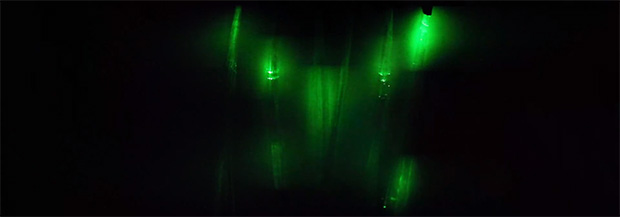
A while back our good buddy [Ch00f] built a QR code clock, unreadable to both humans and computers. A human couldn’t read the clock because of the digital nature of a QR code, and because the clock used persistence of vision in driving the LEDs, a digital camera can’t capture all the pixels in the QR code at the same time. It’s a highly useless but impressive art piece. Now, [Ch00f] is turning that build on its head. He created a rudimentary display that is invisible to the human eye, but easily detected with a digital camera.
This build exploits a basic property of CMOS digital cameras – the rolling shutter. Because it takes time to get pixels off a modern digital image sensor, each picture is actual a composite of many different strips, each taken slightly out of sequence. You can see this for yourself by taking a picture of something rotating very fast with your camera phone; a picture of an airplane propeller will make the blades appear curved, or look like [Dr. Seuss] has an aeronautical engineering degree.
To create his display, [Ch00f] found a few inexpensive fiber optic lights. By aligning a few of these into columns and lighting them up in a precise sequence, he can exploit the rolling shutter and make an image appear. To the human eye, it looks like a solid wall of illuminated fiber optics.
As for how practical this build is, [Ch00f] says not much. For cell phone cameras, you’d need to have a very, very short exposure time for this to work. The only way to do that is to make this display unbelievably bright, or just put it out in the sun. We can’t see that being practical for any potential use case, but we’d be more than happy to see a large-scale attempt at displaying images with this technique.















I have one of the QR Clocks, and my iPhone has no problem reading the code. Of course, the contrast needs to be pretty high. I have it sitting under an overhanging shelf, so it’s a little shaded. However, the photosensor sees the room brightness and ratchets the LEDs down. If I turn off the room lights, it makes the surroundings dim enough to get good contrast.
Wha? I have no problems taking pictures of the RQ Clock or reading the time with Goggles on my S4. Same is true with the iPad.
The qr clock is unreadable “only” in person, the LED matrix captured on video is simply a bitmap, so no “delayed” POV effect here ;)
“A human couldn’t read the clock because of the digital nature of a QR code, and because the clock used persistence of vision in driving the LEDs, a digital camera can’t capture all the pixels in the QR code at the same time. ”
The implication of this statement is that you can’t photograph the QR Clock, which is incorrect.
Or that using QR code reader on it won’t work, which is also incorrect! Guys you did an article on that exact project! Did you even read it?!? Honestly!
According to ch00f this is a mistake on hack a days part. The display works in person as well. In his original article of his qr clock he merely commented that it would be funny to lower the refresh rate so that phones couldn’t read it.
Surely just coming up with a simpler IR (infrared) LED based display would do? Humans can’t see near IR at all of course, but virtually every digital camera easily can – try it by looking via the camera/cellphone at the IR LED on a TV remote etc. It typically shows bright greenish-purple. All manner of simple message & status displays have long been made this way.
Something like this?
http://www.adafruit.com/blog/2013/01/30/infra-ir-display-made-from-tv-remotes/
take the idea/art linked to by ColdTurkey
(redo it with IR_LEDs nextto each like normal led matrix)
combine it with a normal visible (color) led matrix and you have…
…a display with one message for humans
and a second message for cameras only muhahah
and if you add infared-pass filter onto camera
(to block visible light)
then you can overlap and have two seperate videostreams :)
sadly i dont have the money to try such a thing.
maybe someone can build one and show the world
HINT HINT
… R.G.B.Ir. …
you may want to try getting a job at the mpaa and nato (http://en.wikipedia.org/wiki/National_Association_of_Theatre_Owners) and the movie industry to design a system to foil camming new releases to movie theaters.
instead of a projector and screen there would be a pov unit with a spinning bar (like the radio shack pov box from the 80,s and 90,s) in place of the screen and anyone trying to cam the movie would get a distorted picture resembling the airplane propeller in http://ch00ftech.com/2013/07/11/rolling-shutter-display/
It tunes to the specific camera’s rolling speed. There is no “standard” CMOS scan rate…
A better idea would be to project an IR image overlay.
The rolling shutter balloon pop thing was one of the coolest real pictures I’ve ever seen.